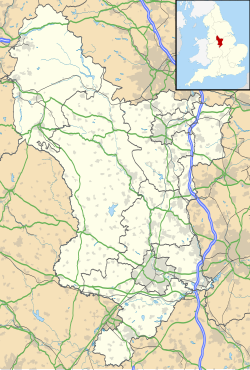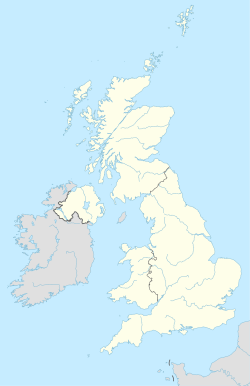RAF Ashbourne
| RAF Ashbourne | |||||||||||
|---|---|---|---|---|---|---|---|---|---|---|---|
| Ashbourne, Derbyshire in England | |||||||||||
| Coordinates | 53°00′25″N 001°42′25″W / 53.00694°N 1.70694°W | ||||||||||
| Type | Royal Air Force station | ||||||||||
| Code | AS[1] | ||||||||||
| Site information | |||||||||||
| Owner | Air Ministry | ||||||||||
| Operator | Royal Air Force | ||||||||||
| Controlled by | RAF Army Cooperation Command 1942-43 RAF Fighter Command 1943- * No. 38 Wing RAF * No. 38 (Airborne Forces) Group RAF | ||||||||||
| Site history | |||||||||||
| Built | 1942 | ||||||||||
| In use | July 1942-1954 | ||||||||||
| Battles/wars | European theatre of World War II | ||||||||||
| Airfield information | |||||||||||
| Elevation | 180 metres (591 ft)[1] AMSL | ||||||||||
| |||||||||||
Royal Air Force Ashbourne, or more simply RAF Ashbourne, is a former Royal Air Force station located approximately 1.5 miles (2.4 km) south-east of the town of Ashbourne, Derbyshire, England.[2]
It was opened on 12 June 1942, before closing on 23 August 1954.[3]
Construction
[edit]Construction of the airfield began in late 1941 to Class-A bomber standards comprising three paved runways (concrete and woodchip surface) in an "leaning A" formation, 30 "frying-pan" style hard standings, four T2 hangars, a control tower and assorted technical buildings. Although at 610 feet (190 m) AMSL the altitude of the area was above the ceiling height for construction of airfields, the necessity of defensive installations during the Second World War overrode this condition.[4]
History
[edit]Ashbourne was home to Armstrong Whitworth Whitley, Armstrong Whitworth Albemarle and Bristol Blenheim aircraft.[5]
Originally planned as a satellite installation of RAF Seighford for Vickers Wellington bombers, due to the unsuitability of altitude and local weather it was relegated to a training role with its own satellite of RAF Darley Moor.
Post war it was used for storage and maintenance of ordnance where the bombs were stored along the runways.[6]
Based units
[edit]There were three small units in operation based at Ashbourne:
- Relief Landing Ground for No. 18 (Pilots) Advanced Flying Unit RAF (March 1945)[7]
- No. 42 Operational Training Unit RAF (OTU) (October 1943)[8]
- No. 81 OTU (July 1942 – January 1944)[9]
- Sub site of No. 28 Maintenance Unit RAF (May 1945 – August 1954)[10]
Current use
[edit]The western half of the site is now an industrial estate, appropriately named Airfield Industrial Estate. The northern half has been used by JCB as a test and demonstration ground for various earth moving products but is now deserted. The north western part of the airfield is now a housing estate.
On the South-East side, part of one runway remains usable, and a 2017 document mentioned 5 aeroplanes based.[11]
References
[edit]Citations
[edit]- ^ a b Falconer 2012, p. 37.
- ^ "RAF Ashbourne, Derbyshire". Airfield Archaeology. Archived from the original on 29 December 2012. Retrieved 9 April 2012.
- ^ "RAF Ashbourne". Airfields of Britain Conservation Trust. Archived from the original on 27 June 2022. Retrieved 9 April 2012.
- ^ "Ashbourne Airfield". Ashbourne Heritage Society. Archived from the original on 12 August 2016. Retrieved 26 June 2016.
- ^ "Escape into The WAAF's". BBC WW2 People's War. Retrieved 9 April 2012.
- ^ "Mustard gas killed everything as it was burnt off on Buxton hills". Derby Telegraph. Archived from the original on 17 July 2015. Retrieved 9 April 2012.
- ^ Sturtivant, Hamlin & Halley 1997, p. 43.
- ^ Sturtivant, Hamlin & Halley 1997, p. 240.
- ^ Sturtivant, Hamlin & Halley 1997, p. 244.
- ^ Sturtivant, Hamlin & Halley 1997, p. 206.
- ^ "The LAAS British Isles Airfield Guide" (PDF) (2017 ed.). LAAS International. Archived (PDF) from the original on 11 May 2023. Retrieved 22 April 2024.
Bibliography
[edit]- Falconer, J (2012). RAF Airfields of World War 2. UK: Ian Allan Publishing. ISBN 978-1-85780-349-5.
- Sturtivant, R; Hamlin, J; Halley, J (1997). Royal Air Force flying training and support units. UK: Air-Britain (Historians). ISBN 0-85130-252-1.


